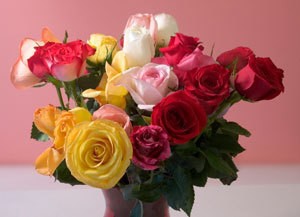
When it comes to flowers and holidays, Poinsettias have Christmas and lilies own Easter. On Valentine's Day, however, few people would argue with the fact that long-stemmed roses reign supreme. Women adore getting them and men enjoy giving them. That probably explains why an estimated 189 million roses are produced for Valentine's Day in 2006. If you're planning to give your sweetheart (friend, relative, boss, etc.) fresh cut roses this Valentine's Day, here's what need to know about buying them and keeping them fresh.
Since the baby-rose boom of the 1990's, roses are now available in more colors, sizes and with greater fragrance than ever before. According to the Society of American Florists, red roses still remain the favorite color choice for Valentines Day-especially among men. Classic red has expanded to a color palette that includes everything from bright raspberry red to a deep burgundy. Roses in other colors are also continuing to gain in popularity. Among a group of women surveyed, 62% stated that hues such as yellow, pink, peach and white were preferred as much as red. For those with more eclectic tastes, lavender and orange are other popular choices.
At the turn of the century, the characteristics of the rose-the size, color and even whether or not the stem contained thorns-were all assigned a meaning and used by the giver to convey a specific message to the recipient. With the dizzying array of sizes, shapes and colors of rose today, maybe some more modern-day interpretations are in order.
Modern meanings according to color theory:
The florist industry isn't trying to shamelessly exploit lovesick consumers by raising the prices of roses in February-at least not entirely. The reason for the sudden spike in the price of long-stemmed roses comes down to economics. Special techniques are used to produce a long-stemmed rose with a single bud and increased demand for around Valentine's Day drives up production costs. The monumental effort required to get 189 million roses ready for one day in February is part of what makes them so special.
Most people don't realize that to meet the high demand for long-stemmed roses during Valentine's Day, many of the roses sold in the United States (over 70%) are imported from Central and South America. Techniques used to grow roses in these countries often involve the use of pesticides that are currently banned or restricted in the U.S. This exposes greenhouse workers (many of whom are children) to hazardous chemicals, and encourages pollution. According to the Organic Trade Association, from stem to store, imported flowers travel and average of 1,500 miles. Not only does importing them contribute to global warming, but it also means you can inadvertently put loved ones at risk for touching or inhaling toxic chemicals. Veriflora' is America's Green Label certification for the floral industry. Certification establishes that practices employed by producers address a variety of sustainable agricultural issues. Ask your florist about Veriflora certified flowers and request they carry roses grown organically. To find Veriflora certified producers and handlers in your area, visit http://www.scscertified.com/csrpurchasing/veriflora/purchasingcertifiedclients.html
Follow these tips for keeping your roses looking Valentine's Day fresh:

About The Author: Ellen Brown is an environmental writer and photographer and the owner of Sustainable Media, an environmental media company that specializes in helping businesses and organizations promote eco-friendly products and services. Contact her on the web at http://www.sustainable-media.com
Add your voice! Click below to comment. ThriftyFun is powered by your wisdom!